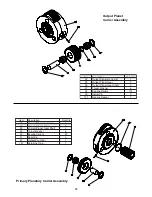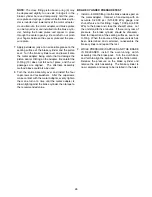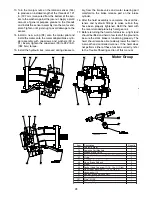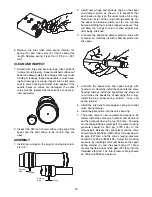
TROUBLE
PROBABLE CAUSE
REMEDY
F
Hoist “chatters” or surges while rais-
ing rated load.
G
1. Same as D2.
2. Hydraulic oil flow to motor may be
too low.
3. Controls being operated too quickly.
4. Hydraulic motor 2-speed control not
shifting correctly.
Same as remedies for Trouble D2.
Same as remedies for Trouble E2.
Conduct operator training as required.
Inspect and repair motor displacement
control.
The wire rope does not spool
smoothly on the drum.
Check mounting distance and fleet
angle. Reposition hoist as required
to achieve
½
to 1
½
degree fleet
angle.
Refer to “Hoist Installation”.
Consult wire rope manufacturer for
recommendation of wire rope that
best suits your application.
Replace wire rope and conduct
operator/rigger training as required.
1. The hoist may be mounted too close
to the main sheave, causing the fleet
angle to be more than 1
½
degrees.
2. The hoist may not be mounted per-
pendicular to an imaginary line
between the center of the cable
drum and the first sheave.
3. Could possibly be using the wrong
lay rope. There is a distinct advan-
tage in applying rope of the proper
direction of lay. When the load is
slacked off, the several wraps on the
drum will stay closer together and
maintain an even layer. If rope of
improper lay is used, the coils will
spread apart each time the load is
removed. Then, when hoisting is
resumed, the rope has a tendency to
criss-cross and overlap on the drum.
The result is apt to be a flattened
and crushed rope.
4. The hoist may have been over-
loaded, causing permanent set in
the wire rope.
19
H
Sensor does not read drum rotation
properly.
1. Sensor may need to be adjusted.
2. Sensor may not have correct supply
voltage.
3. Sensor may be defective.
Rotate drum slowly.
A. If sensor light stays on, loosen lock
nuts and slowly turn the sensor
CCW until sensor light blinks on and
off. Continue turning sensor 1/4 to
1/2 CCW after light blinking starts
and tighten lock nuts until snug to
avoid damage to the sensor.
B. If sensor light does not come on or
blink, loosen locknuts and slowly
turn the sensor CW until sensor light
blinks on and off. Continue turning
sensor 1/4 to 1/2 CW after light
blinking starts and tighten locknuts
until snug to avoid damage to sen-
sor.
Test voltage at sensor plug, pin1,
brown wire. Voltage must be 9-24
volts DC. If voltage is too low or 0
volts, test electrical harness for open
circuit.
Replace sensor. Adjust sensor as
described above in H1.












































